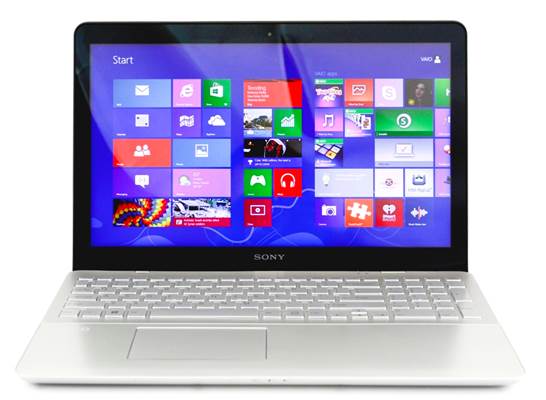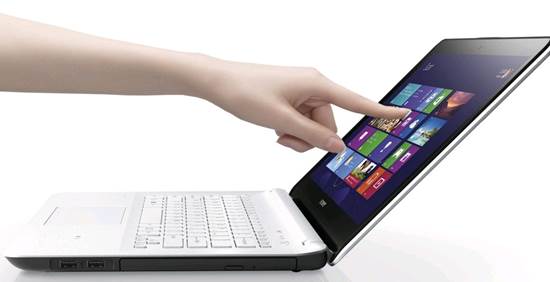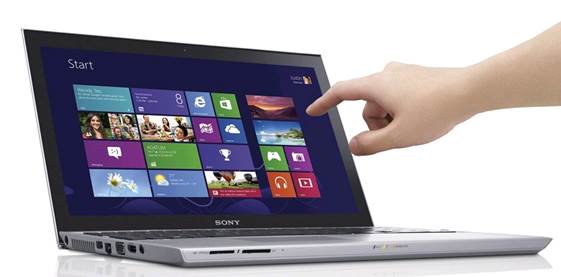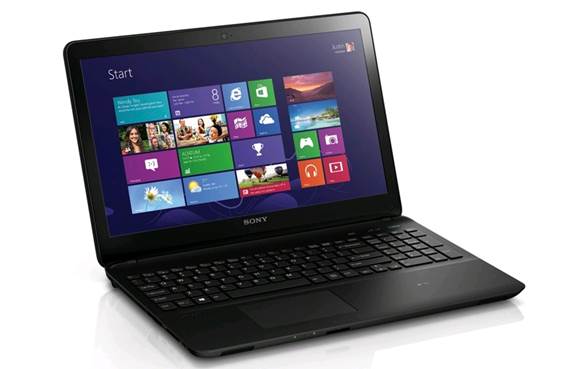Display and Sound
If you type Ctrl-F to zero in on mentions
of "1,366 x 768", this is the only case you'll find related to the
Fit series. With a new generation of laptops, Sony more or less standardized
1920x1080 resolutions, with an exception of the Fit 14 laptop line, which
starts at a resolution of 1600x900. In any event, 720p is a thing of the past,
at least for Sony.
As you might expect, the pixel density of a
15-inch screen with 1080p resolution is not as high as on a smaller computer -
assuming, one with 11-inch or 13-inch screen. From the distance of the desk
chair, objects such as desktop icons typically look sharper on this OLED screen,
and videos in particular look great. In general, we do not have any problems
when watching video or reading text from slightly off to the side (good news if
you plan on hosting a Game of Thrones marathon in your dorm room). We did
notice that colors start to wash out as soon as you push the lid forward, so
please fiddle with the angle before leaning back to back to watch a movie.

Sony
more or less standardized 1920x1080 resolution
If you compare specifications across the
Fit line, you will see one of the models has a subwoofer - the first in the
mainstream series of Sony laptops. However, the strange thing is that model is
not the senior Fit 15 that we are evaluating here, but rather, the entry-level
Fit 15E. Perhaps the limited space is the deciding factor here - the Fit 15 is
supposed to be a thin computer, meaning that the compromise sound quality is
almost by default. In any case, unless your musical tastes skew more about
hip-hop, you should be satisfied with this set. First, it's great - we played
some great music with the volume at 61/100, and were really surprised about how
forceful the sound was. In quite spaces, we usually keep the volume around 15
or 20, lower than most laptops we tested.
Of course, loud sound doesn't necessarily
equate to pleasant sound, but in this case, the quality is also quite balanced.
We love hearing everything from The Clash to the Les Mis soundtrack to various
jazz numbers. There was one Louis Prima track where the nasal horn section
slightly overpowered the other instruments, but in addition, it is easy to
listen to on our end.
Normally, we do not have much to say about
the webcam on the laptops we've tested - no one expects us to create
high-quality images at all. Looking ahead, every new Sony PC will make use of an
Exmor R CMOS sensor (yes, the same kind used in Sony digital cameras). In fact,
the promise of better pictures in low light is one of the laptop's bigger
selling points. And to some extent, that's a gimmick: not sure you will find
yourself in situations where you have no choice but to Skype in the dark.
However, if you can wait for the results as the sample image above, which makes
it appear as if I were sitting in a room with the lights on (they were, in
fact, off).
Performance and Battery Life
Sony VAIO Fit 15 (Core i5-3337U 1.8GHz,
Intel HD 4000)
·
PCMark7: 4,160
·
3DMark06: 5,222
·
3DMark11: E1215/P664/X223
·
ATTO (top disk speeds): 151MB/s (read); 89MB/s
(write)

Sony
VAIO Fit 15
Sony VAIO T15 (Core i5-3337U 1.8GHz,
Intel HD 4000)
·
PCMark7: 3,861
·
3DMark06: 5,050
·
3DMark11: E1099/P603
·
ATTO (top disk speeds): 114MB/s (read); 87MB/s
(write)

Sony
VAIO T15
The Fit 15 starts at $700, and up to
$2,210, so the $949 model we tested falls more toward the low-end range (if one
computer is actually close to $1,000 can be called cheap). With this money, you
have processor 1.8GHz Core i5-3337U (i.e. Ivy Bridge) with 8GB RAM, 750GB hard
drive and Intel HD Graphics 4000 integrated. As you can see, the performance is
equal (if not slightly better than) the other computer with similar specs. It
surpassed a Core i5-enabled T15 in almost all tests, although if you study the
reviews of our Ultrabook, you'll see it keeps pace with many Windows 8 ultra-portables.
(Well, except for disk performance - most Ultrabooks benefit from
all-solid-state storage).
Predictably the 750GB hard drive cannot
compete with an SSD in either read or write speeds, but at least Fit 15 is
faster than T15, whose read speeds were, on average, almost 40 MB/s slower.
More impressive, the startup time of the Fit 15 equals to what we have seen on
many faster Ultrabooks - just 11 seconds, you will be fully loaded into the
Start Screen. It is equal to a $1,200 ultraportable, but not on a mainstream
laptop: the T15 takes 20 seconds to boot.
Sony rates the Fit 15 for up to three hours
and 45 minutes, pretty accurate, at least according to our tests. The model we
tested has lasted 3 hours 37 minutes of video playback (with Wi-Fi open and the
brightness fixed at 65%). That's not great for a 15-inch laptop but then again,
it is heavy enough so that you will plug it in at the desk most of the time.
Software and warranty
The Sony's preinstalled applications extend
over 8 small tiles on the Start Menu - not exactly a small load here. As on the
other computers, you will find many third-party programs, such as Hulu Plus,
Slacker Radio, iHeartRadio, My Daily Clip, PuzzleTouch and Intel's AppUp store.
At the same time, Sony has included several proprietary software, including
VAIO Update, PlayMemories Home, VAIO Movie Creator, VAIO Control Center and
Metro style apps normally only for Windows 8 (which will be Socialife, Music
and Album).

The
Sony's preinstalled applications extend over 8 small tiles on the Start Menu
Sony also launched the Imagination Studio
package, which costs around $ 200, including ACID Music Studio 9.0, Movie
Studio Platinum 12.0, DVD Architect Studio 5.0 and Sound Forge Audio. Sony
plans to bundle that suite on every new PC it releases this summer. Finally,
Sony has included ArtRage Studio, which you will find on such systems that
support different sensors from Sony.
The Fit 15, as all Fit models (and all
consumer PCs in general), comes with 1 year warranty, including telephone
support 24/7.